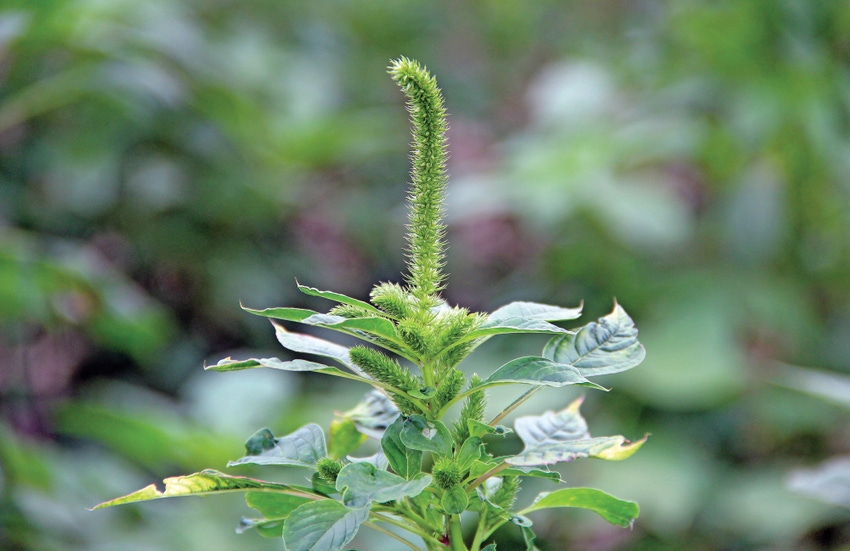
Glyphosate-resistant Palmer amaranth on turnrows and ditchbanks
Managing glyphosate-resistant Palmer amaranth on turnrows and ditchbanks can be problematic. Often glyphosate-resistant Palmer amaranth in these areas is not dealt with until mid- to late-summer after weed control in the crop has concluded. However, by this time, the weeds are often large and difficult to control.
July 20, 2012

Most growers in areas severely affected by glyphosate-resistant weeds realize the severity of the problem and that glyphosate-resistant weeds will be present for the foreseeable future. Control measures such as hand-weeding, which seemed extreme a few years ago, are now routinely utilized to manage glyphosate-resistant Palmer amaranth.
Growers are also becoming more educated on the importance of soil seedbanks and how these impact their weed management programs.
One area of concern in glyphosate-resistant Palmer amaranth management is controlling this species on turnrows, field borders, and ditchbanks. Clean crop fields surrounded on turnrows and/or ditchbanks by glyphosate-resistant Palmer amaranth are common sights in areas where it is prevalent.
Glyphosate-resistant Palmer amaranth has also colonized fallow areas, road sides, and construction sites. When glyphosate-resistant Palmer amaranth in these areas is left uncontrolled, it produces seed which is often disseminated into adjacent fields.
Seed industry’s future tied to herbicide resistance
Control of resistant pigweed comes at a price
NRCS offers financial assistance for resistant weeds
Managing glyphosate-resistant Palmer amaranth on turnrows and ditchbanks can be problematic. Often glyphosate-resistant Palmer amaranth in these areas is not dealt with until mid- to late-summer after weed control in the crop has concluded. However, by this time, the weeds are often large and difficult to control.
The best way to avoid problems along turnrows and ditchbanks is to never let them get “grown up.” Small weeds on turnrows and ditchbanks are much easier to control than large ones. Unfortunately, few operations can afford to have people and equipment dedicated to managing turnrows and ditchbanks, so these areas are often low on the priority list.
Some options are available to manage glyphosate-resistant Palmer amaranth along turnrows and ditchbanks. Unfortunately, none of these are foolproof. Turnrows and ditchbanks may be mowed or tilled to control glyphosate-resistant Palmer amaranth. While these tactics are relatively effective, they must be performed repeatedly because they generally do not control all Palmer amaranth plants and those remaining will produce seed which can re-infest crop fields.
Tillage, usually in the form of disking, is more effective than mowing for control of glyphosate-resistant Palmer amaranth present at the time of the operation. However, disking will require multiple passes and is only effective on turnrows, and a disk is difficult to maneuver around pointed rows and power poles. A rotary mower is much easier to handle than a disk, but it will not kill glyphosate-resistant Palmer amaranth, so the turnrow and/or ditchbank must be mowed repeatedly to avoid seed production.
Cultural tactics
Cultural tactics for managing glyphosate-resistant Palmer amaranth on turnrows and/or ditchbanks include planting turnrows in the same crop as the adjacent field or establishing perennial grasses. Once the crop plant or perennial grass becomes established, these will compete with glyphosate-resistant Palmer amaranth and reduce growth and seed production. Establishing a perennial grass such as bermudagrass is often difficult because most turnrows and ditchbanks are sprayed with glyphosate during normal weed control activities.
Many growers prefer to chemically control glyphosate-resistant Palmer amaranth on turnrows and ditchbanks, but the legality of these herbicide applications is often unclear. Most herbicide labels restrict application to water, but they do not always specify whether application to a ditch with no water is allowed. Some labels, such as dicamba (Clarity) and triclopyr (Garlon, Remedy), specifically address applications to “non-crop” areas. However, “non-crop” area is not clearly defined on most labels.
Although the true definition of a turnrow is vague as it relates to herbicide applications and ditches fall into a number of categories — drainage, irrigation, non-flowing — some points are clear about herbicide applications to turnrows and ditchbanks.
Gramoxone SL is not labeled for application to ditches.
Glufosinate, when applied as Liberty 280 SL, is not labeled for application outside of crop fields. However, glufosinate as Rely 280 may be applied to “farmsteads,” which the herbicide label defines as “non-crop areas around farmstead buildings, shelter belts, along fences, and general nonselective farmstead weed control.”
Although dicamba and triclopyr are labeled for some turnrow and/or ditchbank applications, most crop species are sensitive to these herbicides.
Diquat (1 to 2 quarts per acre), which is a group 22 herbicides similar to Gramoxone SL, is labeled for application to non-crop areas as well as non-flooded ditches.
Direx may be applied to uncultivated agriculture areas at a rate of 4 to 12 quarts per acre. Although Diquat has not been tested extensively for efficacy against glyphosate-resistant Palmer amaranth, it is a non-selective, contact herbicide, so it should at least be effective on small glyphosate-resistant Palmer amaranth.
The combination of Diquat and Direx should control small, emerged glyphosate-resistant Palmer amaranth and provide residual control if the application receives rainfall for incorporation.
Controlling glyphosate-resistant Palmer amaranth on turnrows and ditchbanks has become a critical component to weed control. Unfortunately, not all the concepts related to the herbicide applications in these areas are clearly defined, so caution should be exercised before the herbicides are applied to turnrows and/or ditchbanks.
When deciding to spray a turnrow, the herbicide label and manufacturer should be consulted to determine if the application is legal.
Local drainage districts or state plant boards should be contacted before utilizing a herbicide to control glyphosate-resistant Palmer amaranth on ditchbanks.
You May Also Like



